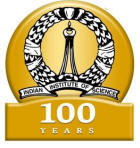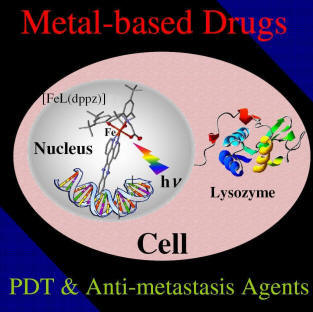
Prof. Akhil R. Chakravarty's Research Group
Coordination and Bioinorganic Chemistry
Department of Inorganic and Physical Chemistry, Indian Institute of Science
Research Interest
Metal-based Anticancer Drugs: 3d-Metal Complexes as Photodynamic Therapeutic (PDT) and Anti-metastasis Agents
The
major focus of our research is to develop the hitherto unknown chemistry
of bio-essential 3d-metal complexes as potential photodynamic
therapeutic (PDT) and anti-metastasis agents. We are designing and
synthesizing metal complexes that have DNA and protein binding
propensities and such complexes could show photo-induced DNA and protein
cleavage activity in visible light. Transition metal complexes with
tunable coordination geometry and versatile spectral and redox chemistry
offer wide scope of designing new PDT agents as substitutes of organic
PDT dyes like porphyrins and phthalocyanins. The metal complexes could
also show photo-induced oxidative DNA cleavage activity following
different mechanistic pathways, while the organic dyes generally follow
only type-II pathway involving formation of singlet oxygen as the
cytotoxic species. Our group is currently
working in designing and synthesizing different types of coordination
and organometallic complexes as photocleavers of protein and DNA in
visible light. We are also exploring the photocytotoxicity of such
complexes using different types of cancer cells.
Copper complexes as photocleavers of DNA: Copper(II) complexes with a 3d9 electronic configuration show a metal-based electronic transition in the PDT spectral window of 600-800 nm. We have designed and synthesized different types of binary and ternary copper(II) complexes having both DNA binding ligand and photosensitizer. We have shown that the cleavage of DNA in red light occurs via metal-assisted photo-excitation pathway involving the metal-based d-d and/or charge transfer bands. With suitable design of the 3d-metal complexes, the mechanistic pathways could be altered from singlet oxygen to hyroxyl radicals. While redox active copper(II) complexes follow the hydroxyl radical pathway, other copper(II) complexes form singlet oxygen as the reactive species. Copper(II) complexes are also designed as models for restriction enzymes showing hydrolytic cleavage of DNA. We have reported copper(II) complexes showing photo-induced DNA cleavage activity under anaerobic reaction condition. This observation is of significance since tumors are known to be generally hypoxic in nature.
Vanadium and Iron-based PDT agents: We have designed and synthesized binary and ternary oxovanadium(IV) and iron(III) complexes as photocleavers of DNA and proteins in visible light. The dipyridophenazine complexes show significant photocytotoxicity in cancer cells. VO2+ complexes with a 3d1 electronic configuration show a metal-centered electronic band in the near-IR region of ~750 nm. We have designed V(IV) complexes that are redox stable and do not show any significant chemical nuclease activity in the presence of cellular reducing thiols. Significant photocytotoxicity of [VO(dppz)2Cl]Cl (dppz = dipyridophenazine) has been observed in HeLa cells on exposure to visible light, while the complex is non-toxic in dark. The oxovanadium(IV) complexes are unique in showing photo-induced DNA cleavage activity in near-IR light. Only lutetium texaphyrin is known to exhibit photocytotoxcity at near-IR wavelength. Vanadium being a bio-essential metal ion, its complexes could be better suited as PDT agents than heavier metal ions like ruthenium and rhodium.
We have explored the photo-induced DNA cleavage activity of several suitably designed mononuclear and binuclear iron(III) complexes. The complexes having photoactive phenanthroline bases show photonuclease activity in visible light. A ternary complex of iron(III) having dipyridophenazine and phenolate-based tetradentate ligand shows in vitro photocytotoxic activity in HeLa and HaCaT cells forming hydroxyl radicals in a photoredox pathway. Oxo-bridged diiron(III) complex of L-histidine is found to photocleave bovine serum albumin (BSA) giving two protein fragments. We are currently working on designing and synthesizing new iron-based PDT and anti-metastasis agents.
Bioorganometallic chemistry in PDT: Bioorganometallic chemistry is an emerging area in chemical biology due to varied biological applications of organometallic compounds. Among different organometallic systems, those based on ferrocene and its conjugates are of particular importance due to excellent stability of the ferrocene moiety in biological media, its lipophilicity, and its reversible redox chemistry. We are exploring the hitherto unknown chemistry of bioorganometallic complexes of 3d-metal ions for PDT applications. The dipyridophenazine complex that shows BSA cleavage activity is a multifunctional model nuclease and protease in the PDT chemistry. The presence of two visible bands due to Fe(II) and Cu(II) makes such systems photoactive over a large spectral window. Ferrocene-conjugated ternary copper(II) complexes having photoactive phenanthroline bases show photo-induced DNA cleavage activity in red light. The Ferrocene-appended 3d-metal complexes that show photo-induced DNA and BSA cleavage activity could be suitably designed for PDT applications targeting both primary and secondary tumors.
Selected publications
Saha, S.; Majumdar, R.; Roy, M.; Dighe, R. R.; Chakravarty, A. R. An
iron complex of dipyridophenazine as a potent photocytotoxic agent in
visible Light. Inorg. Chem. 2009, 48, 2652-2663.
Sasmal, P. K.; Saha, S.; Majumdar, R.; Dighe, R. R.; Chakravarty, A. R.
Oxovanadium(IV)-based near-IR PDT agents: design to biological
evaluations. Chem. Commun. 2009, 1703-1705.
Maity, B.; Roy, M.; Saha, S.; Chakravarty, A. R. Photo-induced DNA and
protein cleavage activity of ferrocene-conjugated ternary copper(II)
complexes. Organometallics 2009, 28, 1495-1505.
Lahiri, D.; Bhowmick, T.; Pathak, B.; Shameema, O.; Patra, A. K.;
Ramakumar, S.; Chakravarty, A. R. Anaerobic photocleavage of DNA in red
light by dicopper(II) complexes of 3,3’-dithiodipropionic acid. Inorg.
Chem. 2009, 48, 339-349.
Roy, M.; Bhowmick, T.; Nethaji, M.; Ramakumar, S.; Chakravarty, A. R.
Double-strand DNA cleavage from photodecarboxylation of (m-oxo)diiron(III)
L-histidine complex in visible light. Dalton Trans. 2008, 3542-3545.
|
|